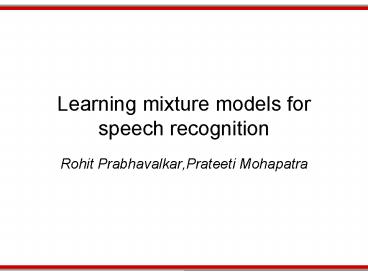Learning mixture models for speech recognition - PowerPoint PPT Presentation
1 / 11
Title:
Learning mixture models for speech recognition
Description:
Usually modeled by a mixture of gaussians for each phone ... Uses eigenvectors of the Kernel Matrix to estimate parameters of a Gaussian Mixture Model ... – PowerPoint PPT presentation
Number of Views:80
Avg rating:3.0/5.0
Title: Learning mixture models for speech recognition
1
Learning mixture models for speech recognition
- Rohit Prabhavalkar,Prateeti Mohapatra
2
Outline
- Introduction
- Learning mixture models using EM with k-means
- The experiment
- Results
- Future Work
3
Speech recognition
- Given acoustic inputs (converted into feature
vectors eg. PLP or MFCCs)? - Find argmax P(QX)?
- Q
- Where,
- Q is most likely phone sequence
- X is the input sequence of feature vectors
4
Conventional techniques for acoustic modeling
- Generative models, such as HMMs, estimate p(xq)?
- Usually modeled by a mixture of gaussians for
each phone - Conventionally this is done by EM, with k-means
initialization
5
Problems with conventional techniques
- EM converges to local maxima
- 'Good' initialization for k-means is critical
- It is usually hard to estimate the number of
gaussians to use
Image taken from http//home.dei.polimi.it/matte
ucc/Clustering/tutorial_html/AppletKM.html
6
Problems with conventional techniques
- EM converges to local maxima
- 'Good' initializations for k-means is critical
- It is usually hard to estimate the number of
gaussians to use
Image taken from http//home.dei.polimi.it/matte
ucc/Clustering/tutorial_html/AppletKM.html
7
The algorithm
- Uses eigenvectors of the Kernel Matrix to
estimate parameters of a Gaussian Mixture Model
- Estimates number of mixtures to use, along
- with means and covariances of each mixture
- Choosing the bandwidth 'w' is a challenge
8
CRFs
- Are discriminative models
- Do not make independence assumptions about the
input unlike HMMs - Have been shown to achieve better performance
than HMMs for speech recogntion
9
The experiments
- Performed phone recognition on the TIMIT dataset
- Used a Tandem System as the baseline
- Test system was based on a CRF
- Needed to randomly sample from the training set
due to time constraints
10
Results
11
Future work
- Lack of time prevented us from experimenting with
different bandwidth values - Could increase number of samples used in the
algorithm - Could use the values predicted by algorithm as
initialization for EM































